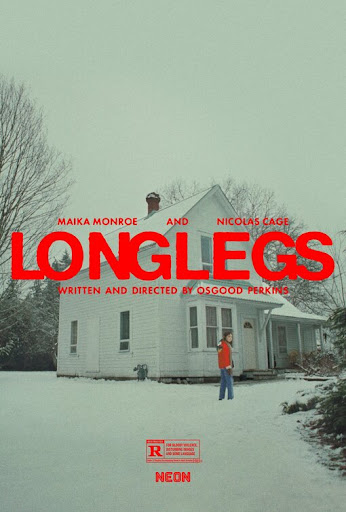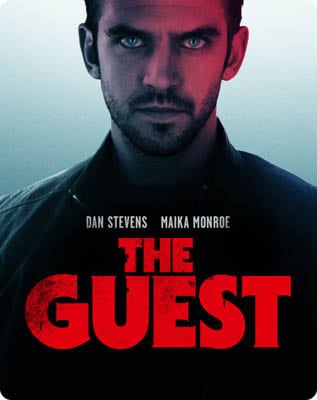Longlegs (2024)
Directed by: Oz Perkins
Written by: Oz Perkins
Starring: Blair Underwood, Maika Monroe, Nicolas Cage

LONGLEGS
Directed by Oz Perkins
At last, it’s here: following months of build-up and numerous claims that it’s among the scariest films of the decade, Oz Perkins’s fourth movie, Longlegs, has hit the cinema. And, at least online, there seems to be a real sense of occasion and anticipation about it – the likes of which I haven’t seen in some time. Perhaps it’s because of how vague the trailers were, with the marketing not showing the biggest star, or maybe it’s the current public enthusiasm for murder investigations. After all, this is a moody serial killer film in which the titular occultist villain (Cage) kills several women and leaves an unnerving letter at the scene of the crime – it’s almost like it’s made for Netflix loyalists. Hunting him down are FBI agents Lee Harker, an obsessive upstart with psychic abilities and low social skills, and her supervisor Agent Carter – a family man who drinks to take the edge of his cases. Their attempts to catch up with Longlegs, who always seems a step ahead, will take them and the viewers into dark, surreal, and often unexpected places.
Oz Perkins is a big name in horror, not just because his dad, Anthony, was genre royalty. As a director, all three of his earlier features showed an eye for shot composition and an ability to find the sweet spot where dreams meet the terrors of daily life. Longlegs is arguably his most conventional movie to date, offering an initially straightforward story that apes a police procedural. We get lots of clinical shots of Lee and Carter staring at photographs of blood spatter, stark shots of the countryside, and reflections on how all-encompassing the job is. The characters are also classic archetypes despite the best efforts of Monroe and Underwood. But to an extent, that’s ok because the film is arguably mimicking Thomas Harris to lull viewers into a false sense of security before it starts to resemble Perkins’ other works better. The second half deviates from the template quite a lot, introducing some more overtly supernatural explanations (weirdly, Carter refuses to believe them, though he casually accepts his partner as psychic).
The camera work here is exceptional as Perkins’ eye swoops suggestively in front of Lee or behind her shoulder but rarely settles anywhere useful. We get long shots where we follow her down corridors populated with gaping doorways, huge windows, or pitch black corners. The effect is that we’re never sure where the threat is going to come from, but we know it’s wherever she isn’t looking, which means we need to constantly scan behind her. Really early on, as in the opening scene, the framing gets under the skin and won’t leave – some of the sequences in the first half are among the most downright creepy I’ve seen in ages. The cuts between a tight 1.33:1 and wide 2.39:1 aspect ratio used to restrict our view or draw attention to particular details in the scene. The sound is also eerily effective, with the soundtrack combining delicate keys and a churning synth. On a technical level, Perkins and his team know how to mess with their audience – it’s the classic horror director as a sadist approach.
Unfortunately, I was less sold on the actual villain. It’s not that Cage does a bad performance – on the contrary, his Marc Bolan meets Charles Manson delivery is another oddball turn in a career marked by them. But by now, his persona is so well-known and meta that, with a few exceptions, the films he appears in almost become about him rather than whatever the story is. In that respect, his presence almost seems like a surreal distraction from a thriller that’s otherwise fairly muted. I get that it’s a contrast, which Perkins has done before, but it works against the carefully constructed suspense. It perhaps doesn’t help that we have a larger-than-life villain, but one short scene aside, we never see what he’s really capable of. Where Silence of the Lambs balances out the investigation with the killings, Perkins intoduces Longlegs as the Joker then treats him like the shark from Jaws.
The result is a film that’ll be memorable even if its individual bits aren’t – we have nothing to rival the fireplace scene of Hereditary, the Babadook closet reveal or the closing moments of The Witch. Frustratingly, it never seems to land upon the intensity implied early on. Part of this may be the rushed third act that, despite sticking to the established aesthetic, introduces too many ideas that it almost feels like the ending of something completely different. Perkins could have developed some of the story beats better, and while his ultimate destination is satisfying, if obvious, a core choice lacks the emotional punch it could have had. Yet horror is often at its best when it lingers, and, to his credit, he has crafted a solid mystery that will haunt you after dark, making you check your house ‘one last time’ before bed.
Rating: 









Be the first to comment